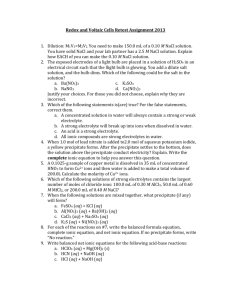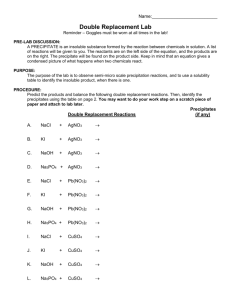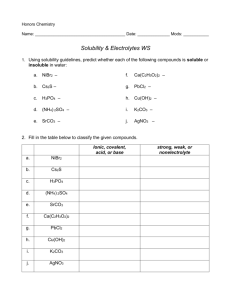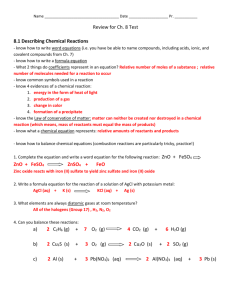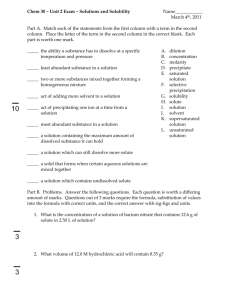EightSolutionLab(revised) - joshuabryant
advertisement
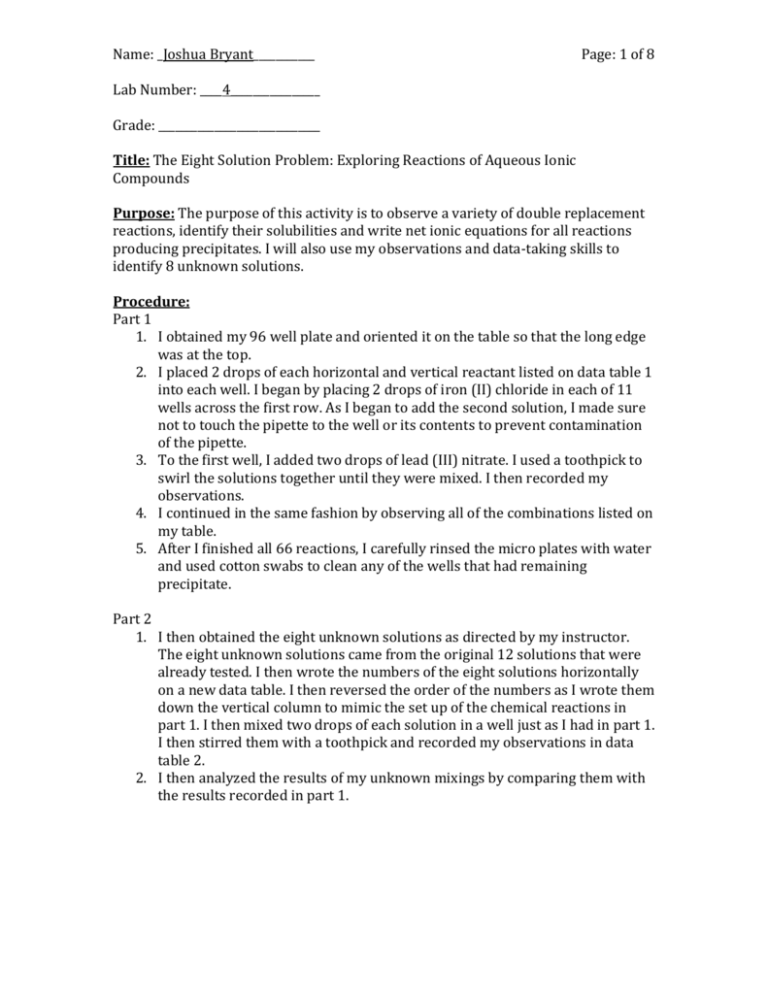
Name: _Joshua Bryant___________ Page: 1 of 8 Lab Number: ____4________________ Grade: _____________________________ Title: The Eight Solution Problem: Exploring Reactions of Aqueous Ionic Compounds Purpose: The purpose of this activity is to observe a variety of double replacement reactions, identify their solubilities and write net ionic equations for all reactions producing precipitates. I will also use my observations and data-taking skills to identify 8 unknown solutions. Procedure: Part 1 1. I obtained my 96 well plate and oriented it on the table so that the long edge was at the top. 2. I placed 2 drops of each horizontal and vertical reactant listed on data table 1 into each well. I began by placing 2 drops of iron (II) chloride in each of 11 wells across the first row. As I began to add the second solution, I made sure not to touch the pipette to the well or its contents to prevent contamination of the pipette. 3. To the first well, I added two drops of lead (III) nitrate. I used a toothpick to swirl the solutions together until they were mixed. I then recorded my observations. 4. I continued in the same fashion by observing all of the combinations listed on my table. 5. After I finished all 66 reactions, I carefully rinsed the micro plates with water and used cotton swabs to clean any of the wells that had remaining precipitate. Part 2 1. I then obtained the eight unknown solutions as directed by my instructor. The eight unknown solutions came from the original 12 solutions that were already tested. I then wrote the numbers of the eight solutions horizontally on a new data table. I then reversed the order of the numbers as I wrote them down the vertical column to mimic the set up of the chemical reactions in part 1. I then mixed two drops of each solution in a well just as I had in part 1. I then stirred them with a toothpick and recorded my observations in data table 2. 2. I then analyzed the results of my unknown mixings by comparing them with the results recorded in part 1. Name: _Joshua Bryant___________ Page: 2 of 8 Lab Number: ____4________________ Grade: _____________________________ Data Analysis: Table 1 Pb(NO3)2 HCl Na3PO4 KI CuSO4 H2SO4 NaOH AgNO3 CaCl2 HNO3 Na2CO3 FeCl3 1 12 22 31 39 46 52 57 61 64 66 Na2CO3 2 13 23 32 40 47 53 58 62 65 HNO3 3 14 24 33 41 48 54 59 63 CaCl2 4 15 25 34 42 49 55 60 AgNO3 5 16 26 35 43 50 56 NaOH 6 17 27 36 44 51 H2SO4 7 18 28 37 45 CuSO4 8 19 29 38 KI 9 20 30 Na3PO4 10 21 HCl 11 The numbers in each cell are labeling to identify the reactions in the next table. Reaction # 1 2 3 4 5 6 7 8 Reactions/Observations Pb(NO3)2(aq) + FeCl2(aq) PbCl2(s) + Fe(NO3)2(aq) Pb2+(aq) + 2Cl-(aq) PbCl2(s) Observations: Solid white precipitate formed along with a yellow liquid. Pb(NO3)2(aq) + Na2CO3(aq) PbCO3(s) + 2NaNO3(aq) Pb2-(aq) + CO32-(aq) PbCO3(s) Observations: Formation of a milky white liquid Pb(NO3)2(aq) + HNO3(aq) No reaction Observations: No change occurred in the well. Pb(NO3)2(aq) + CaCl2(aq) PbCl2(s) + Ca(NO3)2(aq) Pb2-(aq) + 2Cl-(aq) PbCl2(s) Observations: No change in the well was observed. Pb(NO3)2(aq) + AgNO3(aq) No reaction Observations: No change in the well was observed. Pb(NO3)2(aq) + 2NaOH(aq) Pb(OH)2(s) + 2NaNO3(aq) Pb2-(aq) + 2OH-(aq) Pb(OH)2(s) Observations: A white precipitate formed as solid particles. Pb(NO3)2(aq) + H2SO4(aq) PbSO4(s) + 2HNO3(aq) Pb2-(aq) + SO42-(aq) PbSO4(s) Observations: A white precipitate formed that seemed like a fine white powder in suspension in the solution. Pb(NO3)2(aq) + CuSO4(aq) PbSO4(s) + Cu(NO3)2(aq) Pb2-(aq) + SO42-(aq) PbSO4(s) Observations: A white precipitate formed at the bottom of the solution. Name: _Joshua Bryant___________ Page: 3 of 8 Lab Number: ____4________________ Grade: _____________________________ 9 10 11 12 13 14 15 16 17 18 19 20 21 22 23 Pb(NO3)2(aq) + 2KI(aq) PbI2(s) + 2KNO3(aq) Pb2-(aq) + 2I-(aq) PbI2(s) Observations: A bright yellow precipitate formed. 3Pb(NO3)2(aq) + 2Na3PO4(aq) Pb3(PO4)2(s) + 6NaNO3(aq) 3Pb2-(aq) + 2PO43-(aq) Pb3(PO4)2(s) Observations: A white precipitate formed in what appeared to be cloudlike structures suspended in the solution. Pb(NO3)2(aq) + 2HCl(aq) PbCl2(s) + 2HNO3(aq) Pb2-(aq) + 2Cl-(aq) PbCl2(aq) Observations: A white precipitate with the appearance of suspended particles formed. HCl(aq) + FeCl2(aq) No reaction Observations: No change was observed in the well. 2HCl(aq) + Na2CO3(aq) 2NaCl(aq) + H2O(l) + CO2(g) 2H+(aq) + CO32-(aq) H2O(l) + CO2(g) Observations: The solution created a small amount of bubbles. HCl(aq) + HNO3(aq) no reaction Observations: No change was observed in the well. HCl(aq) + CaCl2(aq) no reaction Observations: No change was observed in the well. HCl(aq) + AgNO3(aq) AgCl(s) + HNO3(aq) Ag-(aq) + Cl+(aq) AgCl(s) Observations: A milky white precipitate was formed in the clear solution. HCl(aq) + NaOH(aq) NaCl(aq) + H2O(l) H+(aq) + OH-(aq) H2O(l) Observations: No change was observed in the well. HCl(aq) + H2SO4(aq) No Reaction Observations: No change was observed in the well. HCl(aq) + CuSO4(aq) CuCl2(aq) + H2SO4(aq) No Net onic Equation. Observations: No change was observed in the well. HCl(aq) + KI(aq) HI(aq) + KCl(aq) No net ionic equation. Observations: No change was observed in the well. 3HCl(aq) + Na3PO4(aq) 3NaCl(aq) + H3PO4(aq) No net ionic equation. Observations: No change was observed in the well. 2Na3PO4(aq) + 3FeCl2(aq) 6NaCl(aq) + Fe3(PO4)2(s) 3Fe2+(aq) + 2PO43-(aq) Fe3(PO4)2(s) Observations: An off-white/yellow precipitate was formed. Na3PO4(aq) + Na2CO3(aq) No reaction Observations: No change was observed in the well. Name: _Joshua Bryant___________ Page: 4 of 8 Lab Number: ____4________________ Grade: _____________________________ 24 25 26 27 28 29 30 31 32 33 34 35 36 37 Na3PO4(aq) + 3HNO3(aq) 3NaNO3(aq) + H3PO4(aq) No net ionic equation Observations: No change was observed in the well. 2Na3PO4(aq) + 3CaCl2(aq) 6NaCl(aq) + Ca3(PO4)2(s) 3Ca2+(aq) + 2PO43-(aq) Ca3(PO4)2(s) Observations: A white precipitate formed. Na3PO4(aq) + 3AgNO3(aq) 3NaNO3(aq) + Ag3PO4(s) 3Ag1+(aq) + PO43-(aq) Ag3PO4(s) Observations: A light yellow precipitate forms. Na3PO4(aq) + NaOH(aq) No Reaction Observations: No change was observed in the well. 2Na3PO4(aq) + 3H2SO4(aq) 3Na2SO4(aq) + 2H3PO4(aq) No net ionic equation Observations: No change was observed in the well. 2Na3PO4(aq) + 3CuSO4(aq) 3Na2SO4(aq) + Cu3(PO4)2(s) 3Cu2+(aq) + 2PO43-(aq) Cu3(PO4)2(s) Observations: A light, baby blue precipitate was formed. Na3PO4(aq) + 3KI(aq) K3PO4(aq) + 3NaI(aq) No net ionic equation Observations: No change was observed in the well. 2KI(aq) + FeCl2(aq) 2KCl(aq) + FeI2(s) Fe2+(aq) + 2I-(aq) FeI2(s) Observations: An orange precipitate was formed. 2KI(aq) + Na2CO3(aq) K2CO3(aq) + 2NaI(aq) No net ionic equation Observations: No change was observed in the well. KI(aq) + HNO3(aq) KNO3(aq) + HI(aq) No net ionic equation Observations: A red/yellow liquid was. 2KI(aq) + CaCl2(aq) 2KCl(aq) + CaI2(aq) No net ionic equation Observations: No change was observed in the well. KI(aq) + AgNO3(aq) KNO3(aq) + AgI(s) Ag+(aq) + I-(aq) AgI(s) Observations: A light yellow precipitate was formed. KI(aq) + NaOH(aq) KOH(aq) + NaI(aq) No net ionic equation Observations: No change was observed in the well. 2KI(aq) + H2SO4(aq) 2HI(aq) + K2SO4(aq) No net ionic equation Observations: No change was observed in the well. Name: _Joshua Bryant___________ Page: 5 of 8 Lab Number: ____4________________ Grade: _____________________________ 38 39 40 41 42 43 44 45 46 47 48 49 50 51 2KI(aq) + CuSO4(aq) K2SO4(aq) + CuI2(s) Cu2+(aq) + 2I-(aq) CuI2(s) Observations: An orange precipitate was formed. CuSO4(aq) + FeCl2(aq) FeSO4(aq) + CuCl2(aq) No net ionic equation Observations: Nothing was observed in the well. CuSO4(aq) + Na2CO3(aq) CuCO3(s) + Na2SO4(aq) Cu2+(aq) + CO32-(aq) CuCO3(s) Observations: A blue precipitate was formed. CuSO4(aq) + 2HNO3(aq) Cu(NO3)2(aq) + H2SO4(aq) No net ionic equation Observations: No change was observed in the well. CuSO4(aq) + CaCl2(aq) CuCl2(aq) + CaSO4(aq) No net ionic equation Observations: No change was observed in the well. CuSO4(aq) + 2AgNO3(aq) Cu(NO3)2(aq) + Ag2SO4(aq) No net ionic equation Observations: No change was observed in the well. CuSO4(aq) + 2NaOH(aq) Na2SO4(aq) + Cu(OH)2(s) Cu2+(aq) + 2OH-(aq) Cu(OH)2(s) Observations: A blue precipitate was formed. CuSO4(aq) + H2SO4(aq) No reaction Observations: No change was observed. H2SO4(aq) + FeCl2(aq) 2HCl(aq) + FeSO4(aq) No net ionic equation Observations: No change was observed. H2SO4(aq) + Na2CO3(aq) H2O(l) + CO2(g) + Na2SO4(aq) 2H+(aq) + CO32-(aq) H2O(l) + CO2(g) Observations: No change was observed in the well. H2SO4(aq) + HNO3(aq) No reaction Observations: No change was observed in the well. H2SO4(aq) + CaCl2(aq) 2HCl(aq) + CaSO4(s) Ca2+(aq) + SO42-(aq) CaSO4(s) Observations: No change was observed in the well. H2SO4(aq) + 2AgNO3(aq) 2HNO3(aq) + Ag2SO4(aq) No net ionic equation Observations: No change was observe in the well. H2SO4(aq) + 2NaOH(aq) Na2SO4(aq) + 2H2O(l) 2H-(aq) + 2OH-(aq) 2H2O(l) Observations: No change was observed in the well. Name: _Joshua Bryant___________ Page: 6 of 8 Lab Number: ____4________________ Grade: _____________________________ 52 53 54 55 56 57 58 59 60 61 62 63 64 65 66 2NaOH(aq) + FeCl2(aq) Fe(OH)2(s) + 2NaCl(aq) Fe2+(aq) + 2OH-(aq) Fe(OH)2(s) Observations: A rust colored, solid precipitate was formed. NaOH(aq) + Na2CO3(aq) No reaction Observations: No change was observed in the well. NaOH(aq) + HNO3(aq) NaNO3(aq) + H2O(l) H-(aq) + OH-(aq) H2O(l) Observations: No change was observed in the well. 2NaOH(aq) + CaCl2(aq) 2NaCl(aq) + Ca(OH)2(s) Ca2+(aq) + 2OH-(aq) Ca(OH)2(s) Observations: A white precipitate as fine, white particles was formed. NaOH(aq) + AgNO3(aq) AgOH(s) + NaNO3(aq) Ag+(aq) + OH-(aq) AgOH(s) Observations: A green/brown precipitate was formed. 2AgNO3(aq) + FeCl2(aq) 2AgCL(s) + Fe(NO3)2(aq) 2Ag+(aq) + 2Cl-(aq) 2AgCl(s) Observations: A white precipitate was formed in a yellow liquid. 2AgNO3(aq) + Na2CO3(aq) Ag2CO3(s) + 2NaNO3(aq) 2Ag+(aq) + CO32-(aq) Ag2CO3(s) Observations: A solid white precipitate was formed. AgNO3(aq) + HNO3(aq) No reaction Observations: No change was observed in the well. 2AgNO3(aq) + CaCl2(aq) 2AgCl(s) + Ca(NO3)2(aq) 2Ag-(aq) + 2Cl-(aq) 2AgCl(s) Observations: A clumpy white precipitate was formed. CaCl2(aq) + FeCl2(aq) No Reaction Observations: No change was observed in the well. CaCl2(aq) + Na2CO3(aq) 2NaCl(aq) + CaCO3(s) Ca2+(aq) + CO32-(aq) CaCO3(s) Observations: A white precipitate was formed. CaCl2(aq) + 2HNO3(aq) 2HCl(aq) + Ca(NO3)2(aq) No net ionic equation Observations: No change was observed in the well. 2HNO3(aq) + FeCl2(aq) 2HCl(aq) + Fe(NO3)2(aq) No net ionic equation Observations: No change was observed in the well. 2HNO3(aq) + Na2CO3(aq) H2O(l) + CO2(g) + 2NaNO3(aq) 2H+(aq) + CO32-(aq) H2O(l) + CO2(g) Observations: Heavy bubbling was observed in a clear liquid. Na2CO3(aq) + FeCl2(aq) 2NaCl(aq) + FeCO3(s) Fe2+(aq) + CO32-(aq) FeCO3(s) Observations: An orange precipitate was formed. Name: _Joshua Bryant___________ Page: 7 of 8 Lab Number: ____4________________ Grade: _____________________________ Unknown # 1 2 3 4 5 6 7 8 1 8 14 19 23 26 28 7 2 9 15 20 24 27 6 3 10 16 21 25 5 4 11 17 22 4 5 12 18 3 6 13 2 7 The numbers along the first column and the first row are the identification numbers of the unknown solution. The numbers in the grid are identification numbers of the equations just as in the above table. Table 2 Reaction # 1 2 3 4 5 6 7 8 9 10 11 12 13 14 15 16 17 18 19 20 21 22 23 24 25 Observations/Comparisons Observations: A milky white precipitate was formed in the clear solution. Observations: No change in the well was observed. Observations: A white precipitate was formed in a yellow liquid. Observations: No change was observed in the well. Observations: A solid white precipitate was formed. Observations: A light yellow precipitate was formed. Observations: A clumpy white precipitate was formed. Observations: No change was observed in the well. Observations: No change in the well was observed. Observations: No change was observed in the well. Observations: No change was observed in the well. Observations: A white precipitate was formed. Observations: No change was observed in the well. Observations: No change was observed in the well. Observations: A bright yellow precipitate formed. Observations: An orange precipitate was formed. Observations: An orange precipitate was formed. Observations: No change was observed in the well. Observations: The solution created a small amount of bubbles. Observations: Formation of a milky white liquid Observations: An orange precipitate was formed. Observations: A blue precipitate was formed. Observations: No change was observed in the well. Observations: A white precipitate formed at the bottom of the solution. Observations: Nothing was observed in the well. Name: _Joshua Bryant___________ Page: 8 of 8 Lab Number: ____4________________ Grade: _____________________________ 26 27 28 Observations: No change was observed in the well. Observations: Solid white precipitate formed along with a yellow liquid. Observations: A white precipitate with the appearance of suspended particles formed. Solution Identification: 1. AgNO3 2. CaCl2 3. KI 4. Na2CO3 5. CuSO4 6. FeCl3 7. Pb(NO3)2 8. HCl Conclusion: The product of a double displacement reaction can vary widely, depending on the reactants. Some double displacement reactions produce gas, such as the reaction between hydrochloric acid and sodium carbonate to produce sodium chloride and carbonic acid with the aqueous sodium chloride dissolving in the water and forcing the carbon dioxide out of the solution causing the final products to be aqueous sodium chloride, water, and carbon dioxide. There are also some double displacement reactions that produce no precipitate but change color in the liquid. The reaction still takes place; it is just that the products formed are all aqueous solutions where each has different optical properties. Some double displacement reactions are also neutralization reactions such as the reaction between hydrochloric acid and sodium hydroxide. There are also some double displacement reactions that have no net equation because both of the products are aqueous solutions leaving the products to just form a solution of different ions that are forming and disassociating simultaneously.
